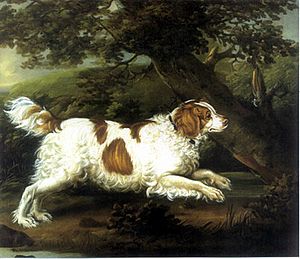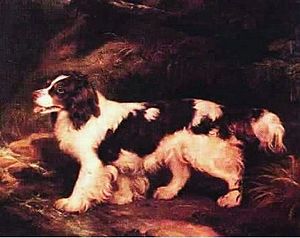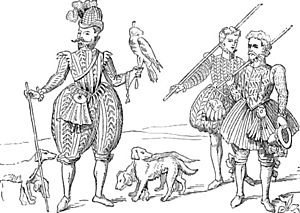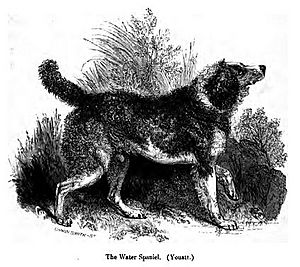English Water Spaniel facts for kids

"Quaille, an English Water Spaniel" (1797) by Henry Bernard Chalon (1770–1849)
|
|
| Other names | Water Dog Water Rug |
|---|---|
| Origin | United Kingdom |
| Breed status | Extinct |
| Domestic dog (Canis lupus familiaris) | |
The English Water Spaniel was a type of dog that is now extinct. The last known English Water Spaniel was seen in the 1930s. These dogs were famous for helping hunters find waterfowl (birds like ducks) and could even dive as well as a duck! People described them as looking a bit like a Collie or a mix between a Poodle and a Springer Spaniel. They had curly fur, often in a white and liver (reddish-brown) color pattern.
This breed existed before the Irish Water Spaniel. Some people even think Shakespeare mentioned them in his play Macbeth. The English Water Spaniel likely influenced many modern dog breeds. These include the American Water Spaniel, the Curly-coated Retriever, and the current Field Spaniel. We don't know if they played a part in creating the Irish Water Spaniel.
History of the English Water Spaniel
In 1570, a doctor named John Caius wrote about a dog called the Water Spaniel. It's believed that Shakespeare also knew this breed. He mentioned a "water rug" in Macbeth. Also, in his play The Two Gentlemen of Verona, a character named Launce says his love "hath more qualities than a water-spaniel." This shows the breed was known back then.
The English Water Spaniel was first mentioned by its specific name in 1802, in a book called Sportsman's Cabinet. The book described the dog as having "hair long and naturally curled, not loose and shaggy." This description came with a picture of a liver and white curly-haired spaniel. This proves the English Water Spaniel existed before the Irish Water Spaniel, which was developed later in the 1830s. Sadly, the person who created the Irish Water Spaniel, Justin McCarthy, didn't keep any written notes. So, we don't know if the English Water Spaniel helped create the Irish Water Spaniel. During the early 1700s, the English Water Spaniel was used for duck hunting in East Anglia, a region in England.
The Kennel Club (a group that registers dog breeds) used to have a category for "Water spaniels other than Irish." This was because there wasn't a specific standard for the English Water Spaniel. A writer named Hugh Dalziel described the judging in this class as "chaos" in his 1897 book, British Dogs. Dalziel believed the breed wasn't truly lost. He thought many old English Water Spaniels were still around the country. He felt that if dog shows encouraged them, the breed could continue and improve. Dalziel was sad that the Irish Water Spaniel became popular, but the English Water Spaniel slowly disappeared into other spaniel breeds.

The Kennel Club's official record book also had a class for "Water spaniels other than Irish." However, only fourteen dogs were registered in this class over twelve years, up to 1903. This made some writers and judges think that the English Water Spaniel was just a mix of the Irish Water Spaniel. Dogs that won prizes as Water Spaniels during this time didn't look like the earlier descriptions of the breed. They were described as having "coats as flat as a Clumber Spaniel, but with a bit of longish hair about the top of the skull."
In 1967, author John F. Gordon wrote that the English Water Spaniel was extinct after two centuries of breeding. He said none had been seen for over thirty years. It's thought that the English Water Spaniel helped create several modern breeds. These include the American Water Spaniel, which also used Irish Water Spaniel and Flat-coated Retriever breeds. The Curly-coated Retriever is believed to come from the Poodle, the retrieving setter, the St. John's water dog, and the English Water Spaniel. We have more exact records for the origin of the modern Field Spaniel. One of the four original dogs used to create this breed was a mix of an English Water Spaniel and an English Cocker Spaniel. This dog was registered as a Sussex Spaniel because of its liver color.
What the English Water Spaniel Looked Like
The English Water Spaniel looked very different from the Irish Water Spaniel. It looked more like a curly-haired version of the English Springer Spaniel. It also had some features of a Collie, poodle, and setter. These dogs were about 20 inches (51 cm) tall. They were typically white and liver (reddish-brown) in color. They looked like a typical, lean, long-legged spaniel with long ears and a long tail. Their belly was white, and their back was brown. The main difference was their coat, which was like that of a water dog.
The English Water Spaniel had a long, narrow head. Its eyes were small, and its long ears were covered in thick, curly fur. Its body was somewhat strong and barrel-shaped, but not as much as the Field Spaniel. Its legs were long and straight, and its feet were large. The size of these dogs varied. The larger ones were called "Water Dogs," and the smaller ones were called "Water Spaniels."
Because the English Water Spaniel was liver (tan) and white, some people think it might be the reason for these colors in the modern English Springer Spaniel and Welsh Springer Spaniel breeds today.
How They Helped with Hunting
Paintings by artists like Henry Bernard Chalon and Ramsay Richard Reinagle show English Water Spaniels working with their owners to hunt ducks. An old picture by Henry Thomas Alken Snr. shows a slightly different looking English Water Spaniel, but it also shows the dog hunting ducks. In a book from 1820 called The Sportsman's Repository, the author suggested that if you wanted to hunt ducks or other waterfowl, the best dog to use was an English Water Spaniel.
The breed was known for swimming and diving as well as the ducks themselves. They were smart enough to avoid being tricked away from the birds' nesting spots. The author of the book said the best English Water Spaniels had long ears. Their fur was white under the belly and around the neck, but brown on their back.




